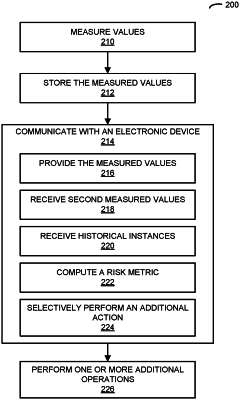| CPC G06F 21/31 (2013.01) [H04L 63/0876 (2013.01); H04Q 9/00 (2013.01); H04W 12/06 (2013.01); H04Q 2209/40 (2013.01)] | 20 Claims |

|
1. An electronic device, comprising:
an interface circuit configured to communicate with a second electronic device that comprises a sensor that performs measurements of a physical parameter, wherein the measurements of the physical parameter performed by the sensor comprise one or more distortions associated with the sensor, wherein the one or more distortions of the sensor comprise semi-stable, time variation of the one or more distortions of the sensor are associated with an internal makeup of the sensor, and the one or more distortions of the sensor vary among different instances of the sensor, wherein the measurements of the physical parameter further comprise one or more environmentally dependent distortions associated with a set of environments, and wherein the sensor has an accuracy exceeding a manufacturer specification associated with the electronic device;
a computation device coupled to the interface circuit; and
memory, coupled to the computation device, configured to store program instructions, wherein, when executed by the computation device, the program instructions cause the electronic device to perform operations comprising:
receiving, from the second electronic device, information that specifies or that corresponds to the one or more distortions of the sensor and the one or more environmentally dependent distortions associated with the set of environments;
determining, based at least in part on the information, the one or more distortions of the sensor and the one or more environmentally dependent distortions associated with the set of environments;
comparing the determined one or more distortions of the sensor with historical values of the one or more distortions of the sensor and the one or more environmentally dependent distortions associated with the set of environments with historical values of the one or more environmentally dependent distortions associated with the set of environments; and
selectively authenticating the individual associated with the second electronic device based at least in part on the comparisons, wherein, during a given time interval, the selective authentication is denied when the second electronic device is located in a second environment that is not included in the set of environments.
|